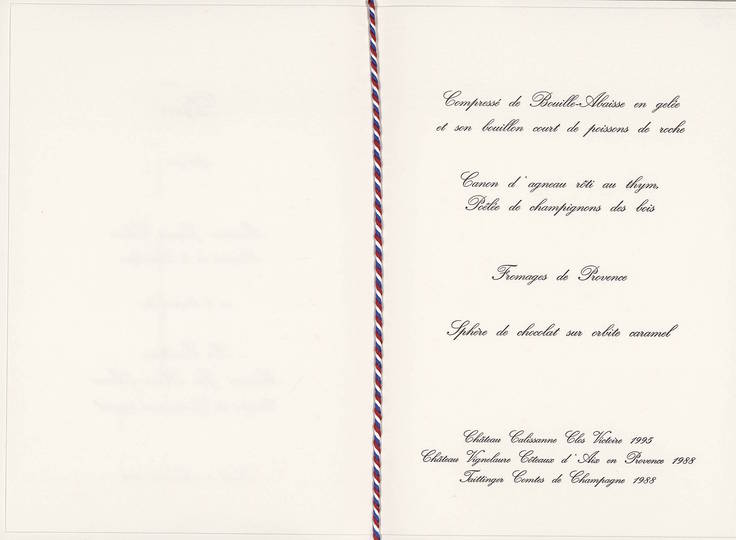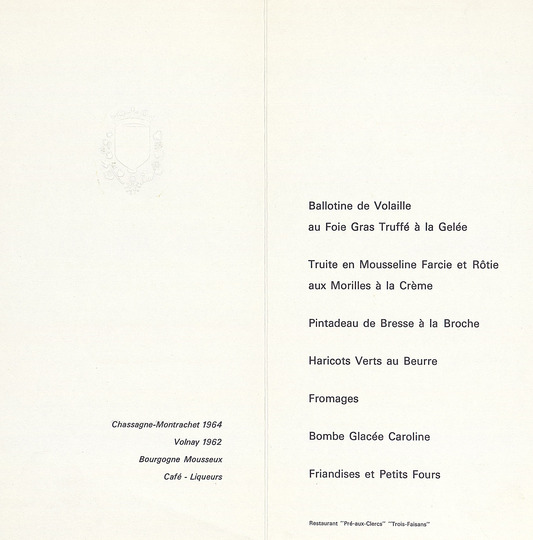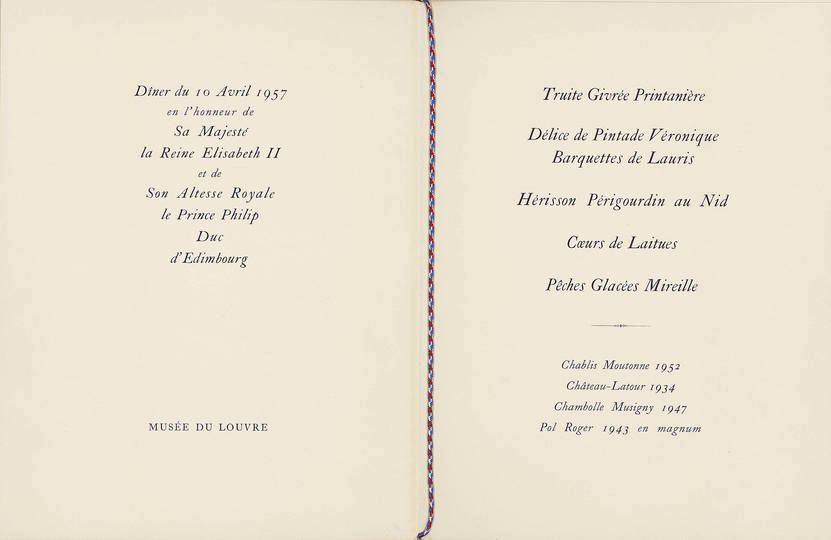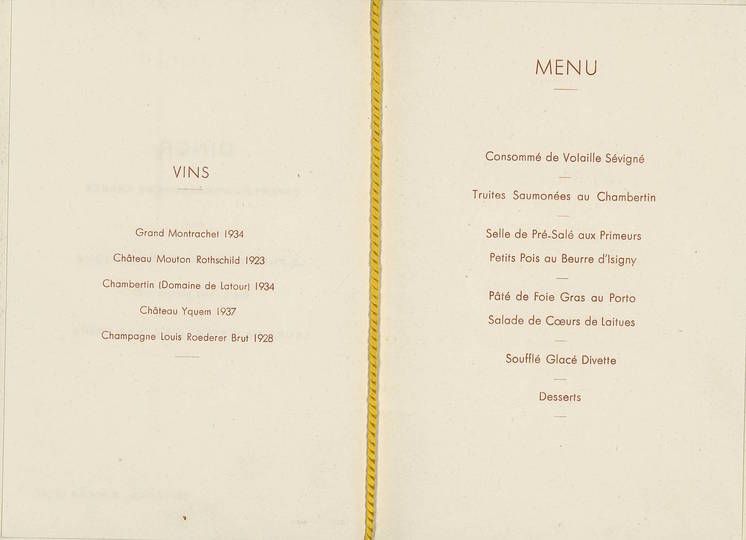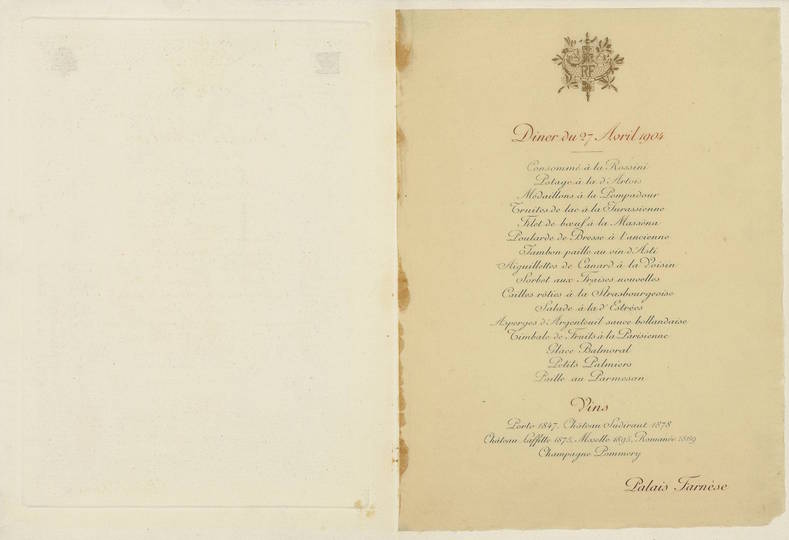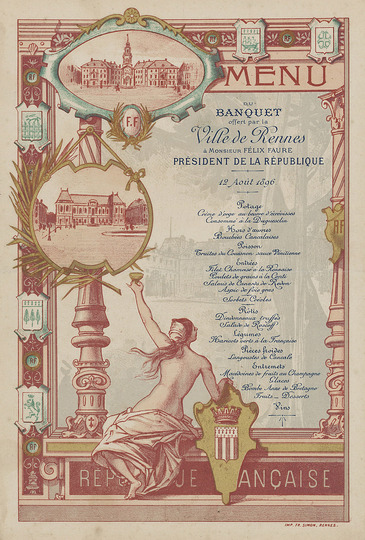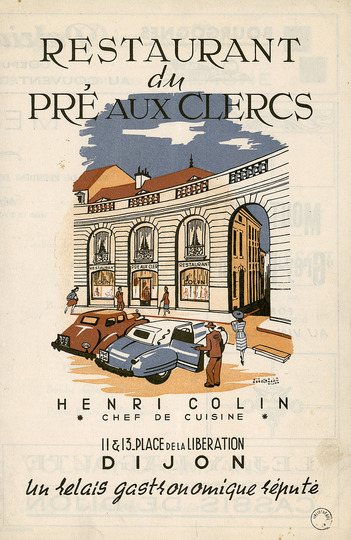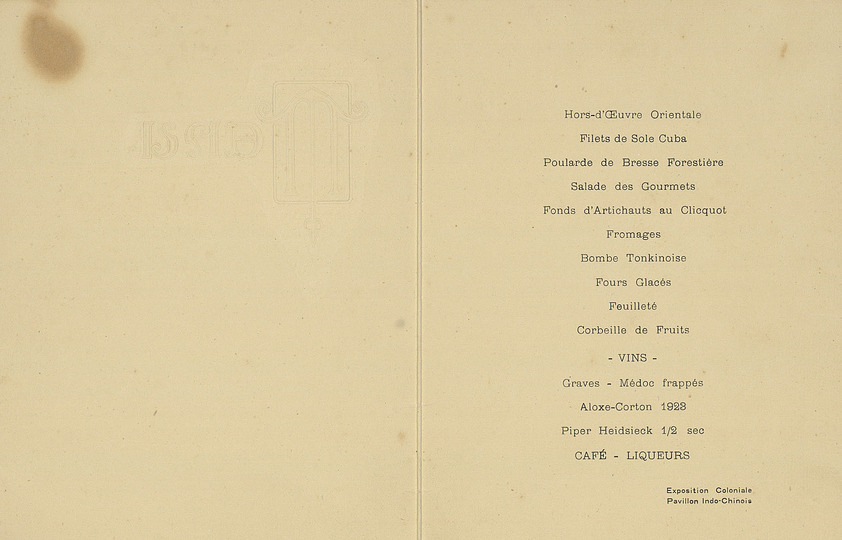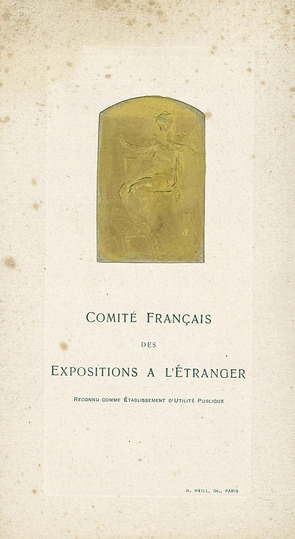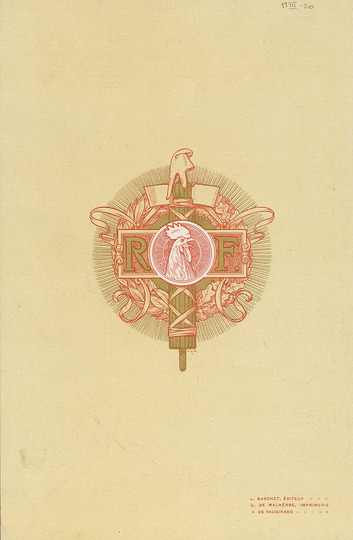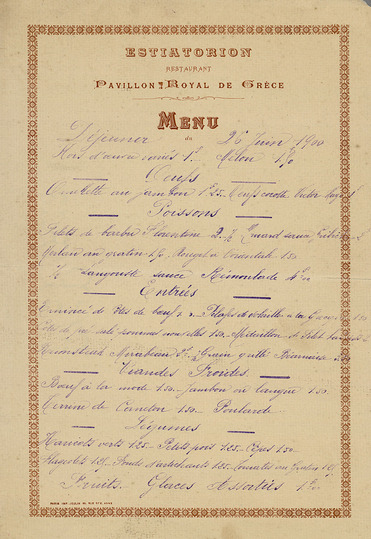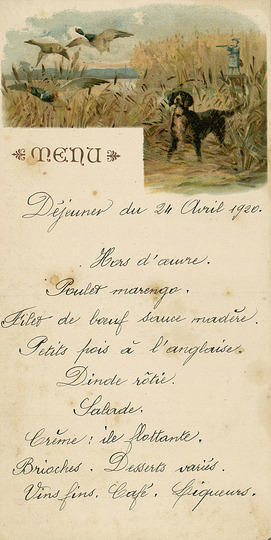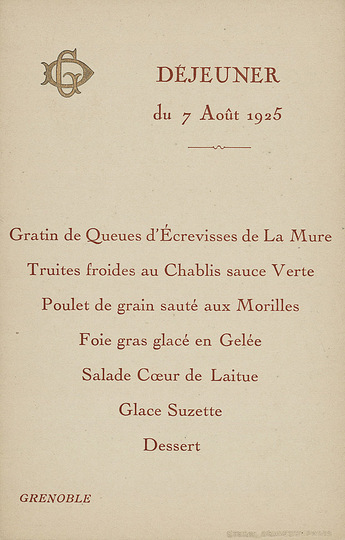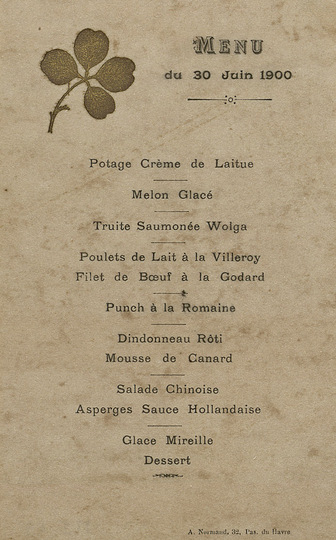The Menu
A menu was superfluous, because the dishes were present and visible on the table, similar to contemporary buffets, if more lavish. The process was repeated at least three times with a minimum of two services de « cuisine » and one fixed service « l’office », whereas nowadays a meal is almost always divided into two parts, salty and desserts.
However, During a meal "à la russe", the dishes have been presented and served one by one, in a sequence determined by the host. The menu becomes necessary to inform guests of the content of the meal. At that time, dishes were more numerous than today - at least a dozen courses.
Urbain Dubois and Émile Bernard, chefs of Emperor William I and authors of "La Cuisine", one of the most important and certainly the most beautiful culinary texts books published in the nineteenth century, compare the French and Russian services:
"In the Service "à la russe", the method of presenting dishes to guests, instead of putting them symmetrically on the table, has the obvious benefit that the delicacies are served in the best conditions of heat and perfect doneness, since once cooked, they are served and eaten immediately. The Russian service has created two variants: the service à l’anglaise (in English style) - the server serves the guest open plates; and the service à l’italienne (in italian style) - the portions come from the kitchen on a plate covered with a silver cloche."
Early food menus have been works of art. To add prestige to the meal, the menu was illustrated to please the eye - this was the era of the engravings of Gustave Doré for the Bible, The Divine Comedy, Orlando Furioso, Don Quichotte and many other classics of literature .
In 1873, the restaurant "La Marmite" was founded in Paris, and soon personalities of the judiciary, the military and government met there. It aimed to restore the greatness of France, to raise their morale and head back toward a great destiny. The menus of "La Marmite" (which began to be printed from 1882) were created exclusively by renowned artists, with only a constraint: integrating a large pot in their composition. At that time, the development of chromolithography had done a great service to the menu: printing in multiple colors accentuated the graphic effect, and it became possible to reproduce many perfectly identical copies at low cost.
At the same time, major brands of champagnes, cognacs, liqueurs and food products commissioned richly illustrated labels. Moët et Chandon commissioned Alphons Mucha in several famous series of high artistic value. Martell has used the services Albert Guillaume, Benedictine liqueur commissioned Louise Abbéma. A few years later in Italy, Fernet-Branca commissioned Marcello Dudovich and Cinzano worked with Carlo Biscaretti and other famous artists.
Inspirations.
Geigy, Swiss and European Graphic Design
Selection of outstanding graphic design from Europe
Book : Monk
A book by Jonathan Monk.
Book : Tajima
A book by Mika Tajima.
Negative Entropy is a series of five abstract Jacquard woven portraits of in...
Book : Lewitt
A book by Sam Levitt.
TEMPLATE is a book whose information emerges under programmatic erasure. Or p...
Book : Baldessari
A book by John Baldessari.
Book : Armleder
A book by John Armleder.
Book : Mullican
A book by Matt Mullican.
Book : Weiner
A book by Lawrence Weiner.
Book : Cattelan
A book by Maurizio Cattelan.
Book : Brannon
A book by Matthew Brannon.
Gaetano Pesce: Abstraction is boring
"Abstraction is boring and limited as a mode of expression. Reducing and reducing designs means that...
American Food
Davide Luciano is a New York based conceptual food and beverage photographer and motion artist. His ...
What Is A Simulation?
What is a simulation?
It is a private game we devise when the aliveness of a situation is too comple...
The algorithm of fashion
Each of these scarf patterns is unique. The production workflow involves an algorithm which creates ...
Books of Memory: Gianpaolo Pagni
Gianpaolo Pagni creates unique, printed, painted or stamped books. His work focuses around memory an...
Groupe Garcia Ingénierie
Corporate identity. Marseille, France, 2015.
Food Architecture
Food dal cucchiaio al mondo: Works of artists and architects who deal with the global political, soc...
Jean Lurçat
Jean Lurcat, painter, poet and ceramicist, great renovator of contemporary French tapestry, produced...
Akiko Masunaga
マスナガデザイン部/Art director/Designer/O型/乙女座
Management 7
7 thoughts on management: Paradox, Management, Hierarchy, Bureaucracy, Trust, Vision, Motivation. (C...
Brazil Modernism
20th century architecture in Brazil, including work by Lina Bo Bardi, Lúcio Costa, Affonso Reidy, O...
Tom Ngo
"Common sense and conventional practice prohibits the evolution of architecture. Through reproducing...
Visual Music
Viktor Hertz was born in Uppsala, Sweden, in 1983. In 2009, he started to do graphic design as a hob...
Heartbeat, Heartseat
Heartbeat consists of a massive heart glowing to the rhythm of a strong, deep and low frequency hear...
Swarm fabrication: Kokkugia / Roland Snooks
We have a fascination with the impact of new technologies on architecture and construction. We are f...
Ignite
"What I try to do is use technology to create representations of imagery found in nature. Technology...
Eric Giraudet de Boudemange
Eric Giraudet de Boudemange (1983) graduated in 2007 from the National School of Fine Arts in Paris ...
Une Cité Industrielle by Tony Garnier
Tony Garnier designed the plans of an ideal city during his stay at the Villa Médicis from 1899 to ...
Liqen
Liqen was born in 1980, in Vigo, a port and industrial city of Galicia, in Spain. Since very little,...
Francois Morellet 1926 - 2016
Since he first began making work in the 1950s, Morellet has been engaged in creating work which has ...
Design & Politics
Photo series "design and politics" by Philippe Jarrigeon, photographer and publisher, born in 1982 i...
Xavier Antin: Printing at Home
A printer manual to disturb and disrupt the printing process.
Xavier Antin, born in 1981, lives and ...
72 dpi
Images on the Internet are changing our lives. While images were once only reserved for a certain fe...
Tea Time
TEA AVE es una marca Canadiense de Tés Oolong. Nos pidieron el desarrollo de la imagen gráfica, la...
Jean-Jaques Lequeu
Jean-Jacques Lequeu (1757-1825) worked as a draughtsman at Rouen, and from 1779 in Paris at the Cad...
Rayan Ayash
Rayan Ayash is a Fashion Photographer based in New York & Paris.
Áron Jancsó
“I’m a type addict. Building from scratch is how I like to work, sometimes even designing every ...
Carreaux
Turn of the century tile and mosaic samples from the Societe Generale de Carrelages in Paris.
Small Buildings
Photographer Eric Tabuchi, born 1959, lives and works in Paris.
The end of history - La fin de l´histoire
"Belief in progress is irresistible. In flattering the eye it blinds us. Standing in the middle of t...
Raymundo Colares
Raymundo Colares (1944 in Grão Mogol, Minas Gerais - 1986 in Montes Claros, Minas Gerais) was a Bra...
Tamara
Tamara de Lempicka (1898 – 1980) was a Polish Art Deco painter. She was the most fashionable portr...
Royère
Jean Royère (1902-1981) worked in the import-export business before working for cabinetmaker Pierr...
Conformity
“Modern man has become a cog in a very complex society. We live in a society that praises individu...
Alain Georges Frank Jacquet
Alain Georges Frank Jacquet was born in Neuilly-sur-Seine in 1939. After studying drama at the Unive...
AG Frozoni: We need to aim at essential things
“We need to aim at essential things, to remove every redundant effects, every useless flowering, t...
Andrea Guccini: 4A+1
Andrea Guccini, born in Bologna in 1993, studied at the IED in Milan. He is living and working betw...
Julien Notter and Sébastien Vigne
Basé à Lausanne, Notter + Vigne est un atelier graphique fondé en 2002 par les designers Julien N...
A+A Cooren
A+A Cooren is a Paris-based French-Japanese design studio founded in 1999 and run by husband and wif...
Erwin Poell: Naturwissenschaft + Technik
Erwin Poell (1930) is a German graphic designer. From 1951 he studied with Walter Brudi at the State...
E. Hu
Eric Hu is an art director based in New York. He previously worked as the design lead at OKFocus. Er...
Serge Mouille
Serge Mouille (1922-1988) studied under Gilbert Lacroix at the École des Arts Appliqués in Paris. ...
Damien Coupeté images
paintings
Pascal Häusermann
Pascal Häusermann was born 19th of November 1936 in Biel, Switzerland. He studied at the School of...
Opie
Julian Opie studied at Goldsmiths´ College (1979-82) under Michael Craig-Martin, for whom he briefl...
Make War, Not Love
Digitally printed charmeuse silk series 'Touchingly Unfeeling' by Jonathan Zawada.
Jonathan Zawada...
Orange mecanique
Philippe Jarrigeon, photographer and publisher, was born in 1982 in France. He graduated from ECAL ...
The Many Sides of the Moon
Variations on light refraction patterns through a prism, in a set-up reminding on the iconic cover o...
Antonio Rubino
Antonio Rubino: Pittore, illustratore e scrittore (Sanremo 1880 - Baiardo 1964). Legato all´art nou...
André Bloc - Sculptures Habitacles
From 1962 to 1966, André Bloc created his habitable sculptures. This work marks the evolution of th...
Sadamitsu Neil Fujita
Sadamitsu Fujita was born in Waimea, Hawaii to Japanese immigrants. He attended boarding school in H...
L´Imparfaite by VLF
VLF studio is Thomas Cristiani and Antoine Roux in Paris.
Symphonie
Posters for the Symphonieorchester des Bayerischen Rundfunks. Bureau Mirko Borsche is a graphic desi...
Life Is Electric. Philippe Weisbecker
Born in 1942, Weisbecker studied interior design in Paris. By 1968 he moved to New York. First worki...
Domestique
Face à une appropriation sous contrôle et une perte progressive des mécanismes d'interaction entr...
Voiture
C´est un travail sur l´expérience et l´émotion du passager dans une voiture d´un futur proche,...
The 2015 best of penccil
This was an extraordinary year. The world went through a series of shocks and shake-ups, and in betw...
Hasui Kawase 川瀬 巴水
Hasui Kawase (1883 – 1957) , the best known proponents of the 新版画 New Prints movement, was ...
France 1661
Views of Renaissance France by Kasper Merian, 1655-1661
HORT
HORT was founded 1994 by Eike König in Berlin. Clients include WALLPAPER, NEW YORK TIMES, PROJECT F...
also:
Eden
Paper sculpture
Surface N° 2
Arctic Paper presents Surface N° 2 – a second edition featuring a specially curated selection of ...
The painted house
These experimental structures have been created by combining design processes of architecture and gr...
SCARABOOK
SCARABOOK is the combination of Scarabottolo and the English word book (but perhaps we ought to say ...
My calendar
I start to make it in 2000, the year in which the future has passed, at the request of Adriano Mei G...
71 views of the magic mountain
In the days of the first lockdown I started making these drawings, remotely inspired by Hokusai´s "...
on paper books and e-books
these drawings were made thinking about what is happening to the books through various titles of cla...
Haribo Centennial
Haribo, the company behind the bear-shaped fruit-flavored jelly candy from Germany, is 100 years old...
Ebb and Flow
This student design project smartly uses paper to give shape to the intertidal coastline of Taiwan, ...
Culinary Tradition
Four examples of contemporary food packaging designs inspired by traditional Chinese patterns and gr...
TRIAL
Old-school postal packaging usually gets little attention from graphic designers. Not so in this fun...
Archip-elles
Swiss graphic designers We Play created this pop-art inspired, fun poster series for the Archipelles...
Kids House
For Inwayi Kids House in Ningbo City, China, designer Nono Xia of graphic design studio Ninemix cam...
Origami envelopes
Origami Envelopes have a special place in Japanese gift-giving culture. The four envelopes here rep...
Les Concerts du mercredi
The idea of Swiss based graphic design practice We Play Design for these posters for Les Concerts du...
Tatsuo Miyajima: Being Coming
Although this is for an exhibition of Japanese contemporary artist Tatsuo Miyajima at Shanghai Minsh...
Yokohama Museum of Art Calendar
Graphic designers Aizawa office from Yokohama designed this wall calendar. With its unassuming but a...
Pulp Fiction
A selection of American and Mexican Pulp Fiction covers from the nineteen-forties.
Synthetic Paradise
Generative music combined with abstract graphics. Click the screen to generate new graphics:
https:/...
Chromaglass
Chromaglass is a cocktail glass displaying its ingredients through colors. An inner insulating conta...
Back in the USSR
Great retro logos from the old USSR, and a Beatles song.
https://soundcloud.com/thebeatlesrevisited...
Faces by 田中 一光 Ikko Tanaka
Inspired by the Bauhaus, by Jazz and by American graphic design, Ikko Tanaka (1930-2002) was one of ...
penccil
Concept, branding, design and coding of penccil, the site for creative people, studios and gallerie...
Pattern generator
A generator for tile and fabric patterns. Drag and drop images and see kaleidoscopic patterns emerge...
Cognition
This experiment looks at the process of human cognition. Letters get progressively filled with color...
Writing & Design
Bohemian Crossroads: Art & Culture Collide Then Subside. Writer and Designer.
Writing & Design
Bohemian Highways: Abide Then Divide Along the California Coast. Writer and Designer.
Writing & Design
Horizon Homes: Living a Concrete Dream. Writer and Designer, Ted Wells.
Writing & Design
Artists Abroad: A Woman´s Journey to Discover the Artists. Writer and Illustrator.
Writing & Design
Bohemian Bridges: California as a Superstructure for Social and Cultural Change. Writer and Designer...
Cooking with myth
IOTAO is a series of IoT - enabled domestic cooking devices for the Chinese market which reinterpret...
Exiled from Truth: Nine Allegories by Dmitry Borshch
"Exiled from Truth: Nine Allegories by Dmitry Borshch"
105 NY-110, Melville, NY 11747
July 10, 11 a...
The Joys of Ice Skating
That skating 400 years ago was one of the most popular winter activities in the Netherlands can be s...
Charles Tassin
Interior designer Charles Tassin has developed a very personal approach to decoration. Merging the s...
Cutting the edges
Arctic Paper launches new swatch books for the brands Arctic, Amber and G-Print, as well as the two ...
The pattern of You
Each name results in a unique pattern. The pattern and colors created are unique to each name, and t...
Functional Pasta
Pasta based on the geometry of a Möbius strip, a geometric surface with the distinction of having o...
Maurice Binder
Maurice Binder was a film title designer best known for his work on 14 James Bond films including th...
Neverending Graphics
Graphics and animations are generated on the fly, resulting in perpetual variations. Move your mouse...
Le Drugstore Brand Identity
Design&Practice designed the brand identity for the newly opened restaurant "Le Drugstore," with int...
Coffee maker
Visualization of the process of coffee making.
The aim was not to use words.
FASHION ADVERTISING
RESEARCH
Design is as much a matter of finding problems as it is solving them.
— Bryan Lawson
— Bryan Lawson
- penccil is free.
- No trackers. No cookies.
Just creativity.









